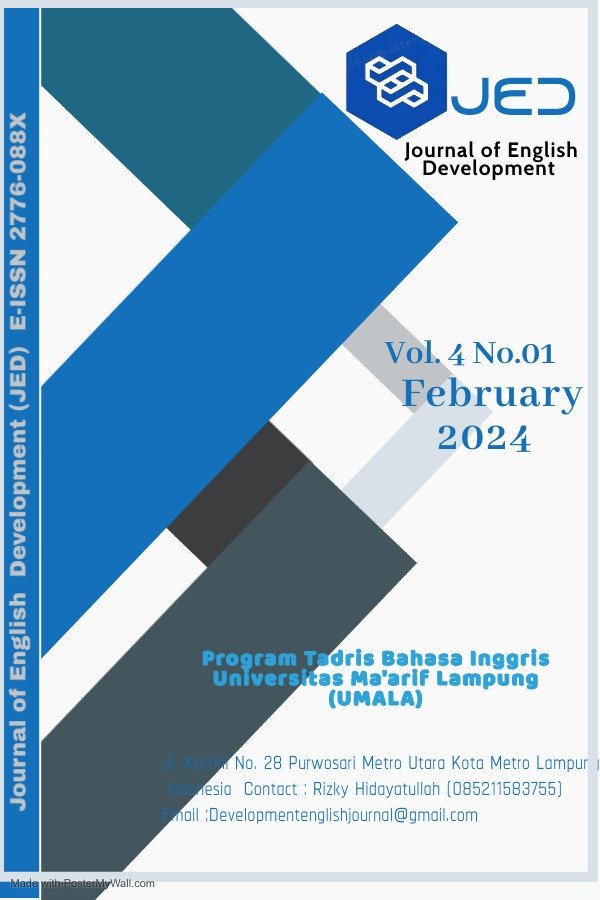Statistical Insights of the Effectiveness Using Serial Cartoon Pictures and Learning Motivation among Eighth Students’ Speaking Skills
English
DOI:
https://doi.org/10.25217/jed.v4i01.4319Keywords:
Speaking Skills, Serial Cartoon Pictures, Learning MotivationAbstract
One of the important skills students need to be learned English is speaking skills because it is complex skills. In learning speaking skills students learn how to write, read, and listen at once indirectly which is important for language communication. But the problem arises when the students feel that English is difficult and the learning method that use are not enjoyable. This research aims to change students’ mindset about learning English and of course improve students’ speaking skills. Also, this research aims to see the effect of using Serial Cartoon Pictures and Learning Motivation on students’ speaking skills. This research was experimental. There are 56 students as samples who have been selected using a simple random sampling technique, half of whom taught using Serial Cartoon Pictures and guided with learning motivation and the rest as comparisons. A questionnaire and speaking test were used to collect the data. The result showed that Using Serial Cartoon Pictures as a media and learning motivation as a reference for guidance can improve students’ speaking skills; as shown by the calculation analysis data result of 2 rater, most students reached more than half the maximum score of speaking rubric. Also, statistical result revealed that the calculation of p-output was lower than 0.05.
References
Baidawi, A. (2016). USING VISUAL MEDIA IN TEACHING SPEAKING. In OKARA Journal of Languages and Literature (Vol. 1).
Brown, H. D. (2001). Teaching by Principles: An Interactive Approach to Language Pedagogy. Longman.
Creswell, J. (2012). Fourth Edition: Educational-Research - Planning, Conducting, and Evaluating, Quantitative and Qualitative Research.
Gaspersz, S., & Uktolseja, L. J. (2020). The Use of Serial Picture Media to Improve English Speaking Ability at SMP YPK Syaloom Klademak Sorong City. Jurnal Pendidikan Bahasa, 7(2).
Gopalan, V., Bakar, J. A. A., Zulkifli, A. N., Alwi, A., & Mat, R. C. (2017). A review of the motivation theories in learning. AIP Conference Proceedings, 1891. https://doi.org/10.1063/1.5005376
Hadryanti, F., & Narius, D. (2016). TEACHING SPEAKING BY USING SHORT CARTOON MOVIES TO SENIOR HIGH SCHOOL STUDENTS. Journal of English Language Teaching, 5(1). http://ejournal.unp.ac.id/index.php/jelt
Mega, I. R., & Sugiarto, D. (2020). Speaking Skill in Correlation with English Speaking Learning Habit and Self Confidence of Vocational High School Students. Journal of Foreign Languange Teaching and Learning, 5(2). https://doi.org/10.18196/ftl.5253
Rahmiati. (2022). THE USE OF SERIAL PICTURE MEDIA IN IMPROVING THE ENGLISH SPEAKING SKILLS OF CLASS XI IPA 1 STUDENTS OF SMA NEGERI 12 SINJAI. Journal of Literate, 03. https://doi.org/10.47435/jle.v1i2
Tajik, O., & Golzar, J. (2022). Simple Random Sampling. https://doi.org/10.22034/ijels.2022.162982
Usman, S., Marhum, M., Suriaman, A., & Pattu, A. (2021). DIFFERENCES ON STUDENTS’ LEARNING OUTCOMES WITH HIGH AND LOW ACHIEVEMENT MOTIVATION. Jurnal Pendidikan Islam, 4(2), 259–272. https://doi.org/10.37758/jat.v4i2.290

Downloads
Published
How to Cite
Issue
Section
License
Copyright (c) 2024 Endah Agustiani, Tahrun, Mulyadi

This work is licensed under a Creative Commons Attribution-ShareAlike 4.0 International License.





